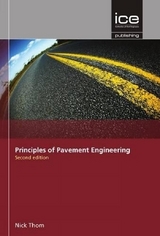
Principles of Pavement Engineering
Thomas Telford Ltd (Verlag)
978-0-7277-3480-8 (ISBN)
- Titel erscheint in neuer Auflage
- Artikel merken
Principles of pavement engineering offers sound engineering understanding to those learning, practising or researching in this field. It is concerned with the basic principles underlying material behaviour, pavement design and maintenance, and will allow the reader to move beyond a mere following of design standards and become able to tackle problems outside the scope of such requirements.
Nick Thom specialises in the design of a wide range of pavement types. He currently divides his time between the University of Nottingham, where he is a part-time Lecturer, and Scott Wilson Pavement Engineering where he is a Pavement Consultant. In add
Chapter 1 - INTRODUCTION
Short description of what a pavement is and what it does, what can go wrong with it and how to prevent it.
Chapter 2 - EMPIRICAL PAVEMENT DESIGN
2.1 - Characterizing Materials
The CBR test, plasticity, concrete compressive strength, pen and softening point, Marshall design of asphalt.
2.2 - The AASHO Road Trials
4th power law; AASHTO designs; Road Notes 29 and 31
Chapter 3 - PAVEMENT MATERIALS
3.1 - Soils and Unbound Materials
Frictional and cohesive soils, compaction, permeability, drainage; resilient behaviour (k-theta, Brown etc); behaviour under multicyclic loading; grid reinforcement.
3.2 - Cement and Hydraulically Bound Materials
Hydration, strength gain, shrinkage; compressive and tensile strength; fatigue; crack deterioration; thermal properties; reinforcement; durability.
3.3 - Asphalt
Bitumen viscosity, temperature and loading rate, fracture, chemistry, ageing, foamed bitumen, emulsion; mixture stiffness, multicyclic load, fatigue, filler effect, reinforcement; curing, durability.
Chapter 4 - PRACTICAL PAVEMENT CONSTRUCTION
4.1 Earthworks; Granular or Hydraulically Bound Layers
Layer thickness, compaction, drainage, level control, edge effects, curing, prime coats.
4.2 Concrete
Plant mixing, placement technique, tolerances, reinforcement, joint forming, dowels, surface finish.
4.3 Asphalt
Asphalt production, paver control, compaction, temperatures, layer thickness and stone size, bond coats.
Chapter 5 - DAMAGE DUE TO TRAFFIC LOADING
5.1 - Surface Deterioration
Skid resistance; polishing, abrasion, ravelling, fretting.
5.2 - Rutting
Subgrade deformation, drainage; granular materials; asphalt rutting; deformation in CBM base.
5.3 - Cracking
Surface cracking in asphalt; asphalt base cracking; concrete slabs; reflective cracking.
Chapter 6 - DAMAGE DUE TO ENVIRONMENTAL EFFECTS
6.1 - Water Damage
Water sources; asphalt durability, interfaces; hydraulically bound materials, cold-mix asphalts; softening of subgrade, influence of drainage.
6.2 - Frost Damage
Penetration; ice in asphalt, hydraulically bound materials, cracks, debonded interfaces; aggregate failure; frost heave.
6.3 - Thermal Cycling
Thermal cracking of asphalt, hydraulically bound material; concrete warping; reflective cracking.
6.4 - High Temperatures
Asphalt surface effects; ageing; blow-up failures.
Chapter 7 - ANALYSIS METHODS
7.1 - Multi-layer Linear Elastic
Input-output; degree of realism; edges, cracks and joints; bond.
7.2 - Westergaard and Meyerhof
Input-output; limitations, assumptions.
7.3 - Other Techniques
Odemark, Olcrack, granular pavements, FE.
Chapter 8 - PAVEMENT DESIGN
8.1 - Basic Principles
Protecting the subgrade; short-term and long-term; constructability; supporting each layer adequately; protecting vulnerable materials from the environment
8.2 - Soft Ground
Shear stress or vertical subgrade strain; in-situ stabilization; geotextiles; construction traffic issues, compaction of overlying layers.
8.3 - Frequent Traffic
Fatigue characteristics for design; access for maintenance.
8.4 - Heavy Loads; High Pressures
Material stability; use of concrete, blocks.
8.5 - Traffic Speed
Appropriate surface type, skid resistance; design stiffness; dynamic load effects; slow speed loading of asphalt.
8.6 - Temperatures
Surface stability, resistance to thermal cracking, ageing; limiting asphalt thickness.
8.7 - Probability, Confidence and Risk
Effect of thickness tolerance, material property uncertainty, subgrade variation, traffic.
Chapter 9 - REHABILITATION
9.1 - Evaluating Condition of Existing Pavement
History; visual condition, drainage, radar, cores, trial pits; skid resistance; IRI; deflection data; laboratory data; diagnosis.
9.2 - Long-term Design Parameters, Risk and Confidence
Down-rating, subgrade improvement with drainage.
9.3 - Design Principles
Local repairs, ride quality issues, retex
| Erscheint lt. Verlag | 18.6.2008 |
|---|---|
| Sprache | englisch |
| Maße | 156 x 234 mm |
| Gewicht | 960 g |
| Themenwelt | Technik ► Bauwesen |
| ISBN-10 | 0-7277-3480-6 / 0727734806 |
| ISBN-13 | 978-0-7277-3480-8 / 9780727734808 |
| Zustand | Neuware |
| Haben Sie eine Frage zum Produkt? |
aus dem Bereich



